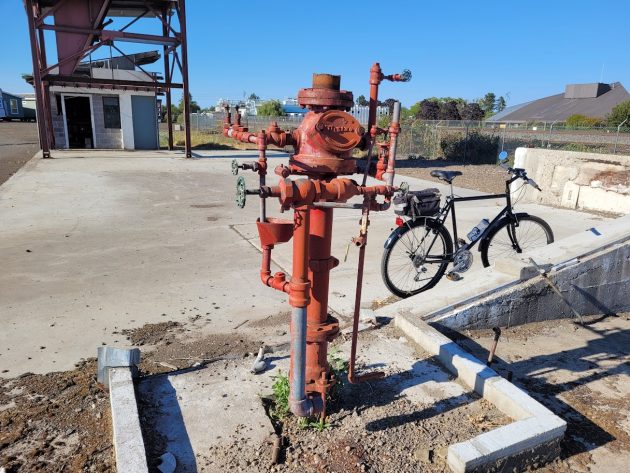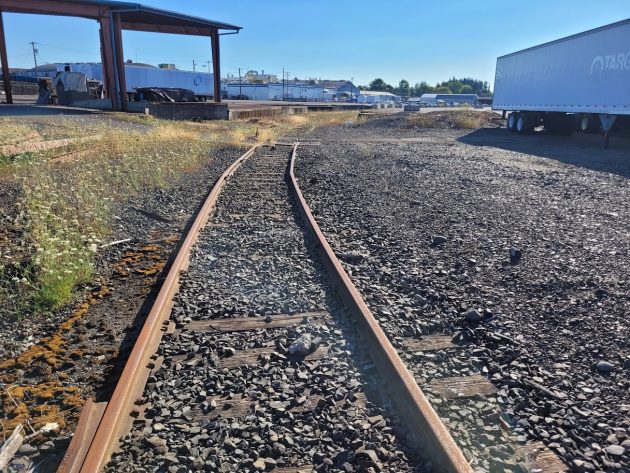
This contraption of valves and pipes had a use back in the day, but just what use was that?
On a bike ride up Pacific Boulevard this month I turned east on 29th Avenue, which ends at the railroad tracks after about 1,300 feet. There, this faded red artifact from Albany’s industrial past caught my eye.
It sits on what used to be the back part of a plywood mill. Several more items like it are spaced along the property line on 29th. I’m guessing they are a type of hydrant, maybe part of the mill’s fire suppression system.
There’s a name on the thing: “Viking.” The Internet says there’s a company by that name. And yes, it makes hydrants.
I remember attending games at West Albany’s Memorial Stadium in the 1980s and occasionally seeing smoke from an industry on the other side of Pacific.
A visit to the Albany Regional Museum and a tour through old papers on Newspapers.com refreshed my vague memory of what used to be on that site.
It was the Stone Forest Plywood Mill when it closed forever in 1994. The year before, during a shutdown blamed on poor market conditions, the Democrat-Herald described it as Albany’s only remaining plywood mill and said it employed 270.
The mill was founded as Hub City Plywood in 1955. Later it was combined with Three Sisters Plywood. Through the years it changed hands several times until Stone Forest eventually shut it down.
In 2004, Walmart filed an application with the City of Albany to build a supercenter on 23 acres between 28th and 29th avenues, including the former Stone Forest mill. The proposal ran into opposition from Oregon Freeze Dry, south of 29th. It foundered on a state planning rule related to traffic.
Three years later, in April 2007, the city council voted unanimously to approve a request by Freeze Dry President Herb Aschkenasy to vacate a section of 29th between the former mill site and the Freeze Dry properties on the south side.
Today, a mostly empty concrete slab covers the roughly 5 acres of the former mill property that borders 29th. Freeze Dry owns it.
An abandoned spur connects the site to an equally disused and rusted railroad track paralleling the Union Pacific mainline. And then there are those “Viking” fixtures, reminding us of what was there. (hh)

The company name remains on the old fixture.

This old spur goes nowhere now.

Sprinkler system riser
Interesting! Thanks!
steam is my guess
You mentioned Hub City in your article. That name in association with Albany seems to come up every now and then. For us newbies, can you gave a history for that name in association with Albany some time?
Thanks.
Albany became the manufacturing and transportation hub of the Willamette Valley. Foundries, blacksmith shops, furniture factories, tanneries, a bag factory, carriage factories, flour and flax mills, a twine factory, creameries and sawmills supplied local farmers and processed their crops.
History of Albany
albanyoregon.gov/history
Hasso, as a long-time editor of our local paper, you should know that Stone Forest Plywood mill was on 29th, and also remember about Walmart trying to build at old mill site, which would have made perfect sense. (Shame on you, Oregon Freeze Dry, for blocking that.) Now most Albanyites have to drive extra miles to get to Walmart; it has better prices than any other large grocery store with a wide variety of products. (I exclude Winco because you can’t use your credit card there (and get credit card rewards points)…can only use a debit card.)
You should also know that Albany was a timber town since World War II. Remember the Timber Carnival!! It was a timber town long before it was a metals industry town.
It is part of the fire suppression system
And now freeze dry is gone. Maybe a good place to put a overpass. Would love to have you do another story on the conductors and the way they use the train horn, but just the switching yard. Dash dash dot dash. Why can’t they do the timing all the same? You can hear the switching train anywhere in Albany.
Especially now that it’s a louder horn. They are mandated by federal law to blow the horn when crossing the intersection. Too bad we cannot designate.
A timing for the blast of the horn and the decibel rating for that horn. Well, going two miles an hour or less across the intersection at queen street at all hours of the day and night. I’m only speaking of the switching train on the switching tracks. Not trains on the main line or amtrak.
Our switching yard is very important to our economy. First it comes over the ocean then it comes by rail and then by truck. Thanks for having this forum for us hasso.